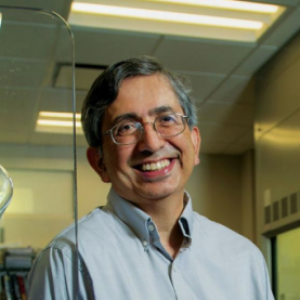Dr. Vijay John
Professor

Areas of Expertise
Biography
I work in the highly interdisciplinary areas of lipid self-assembly, drug and vaccine delivery, and the development of nanostructured materials. The self-organization of amphiphilic molecules (such as biological lipids and synthetic surfactants) is essential in technologies as mundane as consumer detergent products and those of the future as in the development of structured, responsive nanomaterials. Biological membranes are ubiquitous examples of lipid-self assembly that impact the entire function of a cell. A major project that I am now working on is in the exploitation of lipid self-assembly to induce transcutaneous vaccine delivery. Vaccine development and needle free vaccine delivery is a grand challenge problem being addressed by researchers at the Medical School and at the Uptown Campus at Tulane, and I am privileged to be part of this group. Funding for my research comes from the National Science Foundation, the National Institutes of Health and the Environmental Protection Agency.
An entirely separate problem I am working on is the development of technologies based on clathrate hydrates. These are inclusion compounds of gas and water where the water molecules form cage-like structures to encapsulate gas molecules. They have tremendous implications in natural gas recovery, processing and storage. Together with colleagues at Tulane, Hamilton College and Los Alamos National Laboratories, we are trying to exploit novel clathrate systems for use in hydrogen storage for next generation fuel-efficient vehicles. This research is funded by the Department of Energy.
Education
Columbia University:
Pennsylvania State University
The Indian Institute of Technology
Articles
Solution Self-Assembly of Block Copolypeptoids with a Crystallizable Core-Forming Block
2020
In this study, we investigate the solution self-assembly of coil-crystalline diblock copolypeptoids with one polypeptoid block having long n-alkyl side chains. Poly(N-methyl glycine)-b-poly(N-decyl glycine) (i.e. PNMG-b-PNDG) with lower volume fraction of the crystalline PNDG blocks were found to slowly self-assemble into one-dimensional long worm-like nanofibrils in methanol, which is induced by the crystallization of core-forming PNDG.
Clay Nanotube Liquid Marbles Enhanced with Inner Biofilm Formation for the Encapsulation and Storage of Bacteria at Room Temperature
2019
Reversing the organization of oil-in-water Pickering emulsion formed with halloysite nanoclay, liquid marbles were created with water droplets encapsulated by a layer of clay nanotubes. After incorporating microorganisms inside the spherical liquid marble of 0.5 mm in diameter, the simple clay capsule has potential as a storage vehicle for bacterial cultures.
Targeted and Stimulus-Responsive Delivery of Surfactant to the Oil–Water Interface for Applications in Oil Spill Remediation
2019
The use of chemical dispersants is a well-established approach to oil spill remediation where surfactants in an appropriate solvent are contacted with the oil to reduce the oil–water interfacial tension and create small oil droplets capable of being sustained in the water column.
Media Appearances
Sponge can soak up and release spilled oil hundreds of times
“I see it as a major advance in cleaning small spills and spills close to coastlines where dispersants cannot be used easily,” says Vijay John at Tulane University in New Orleans, Louisiana.
Life sciences: All jazzed up
“This part of the country has become very attractive to people who are very idealistic and want to make a difference,” says Vijay John, a chemical engineer at Tulane.
